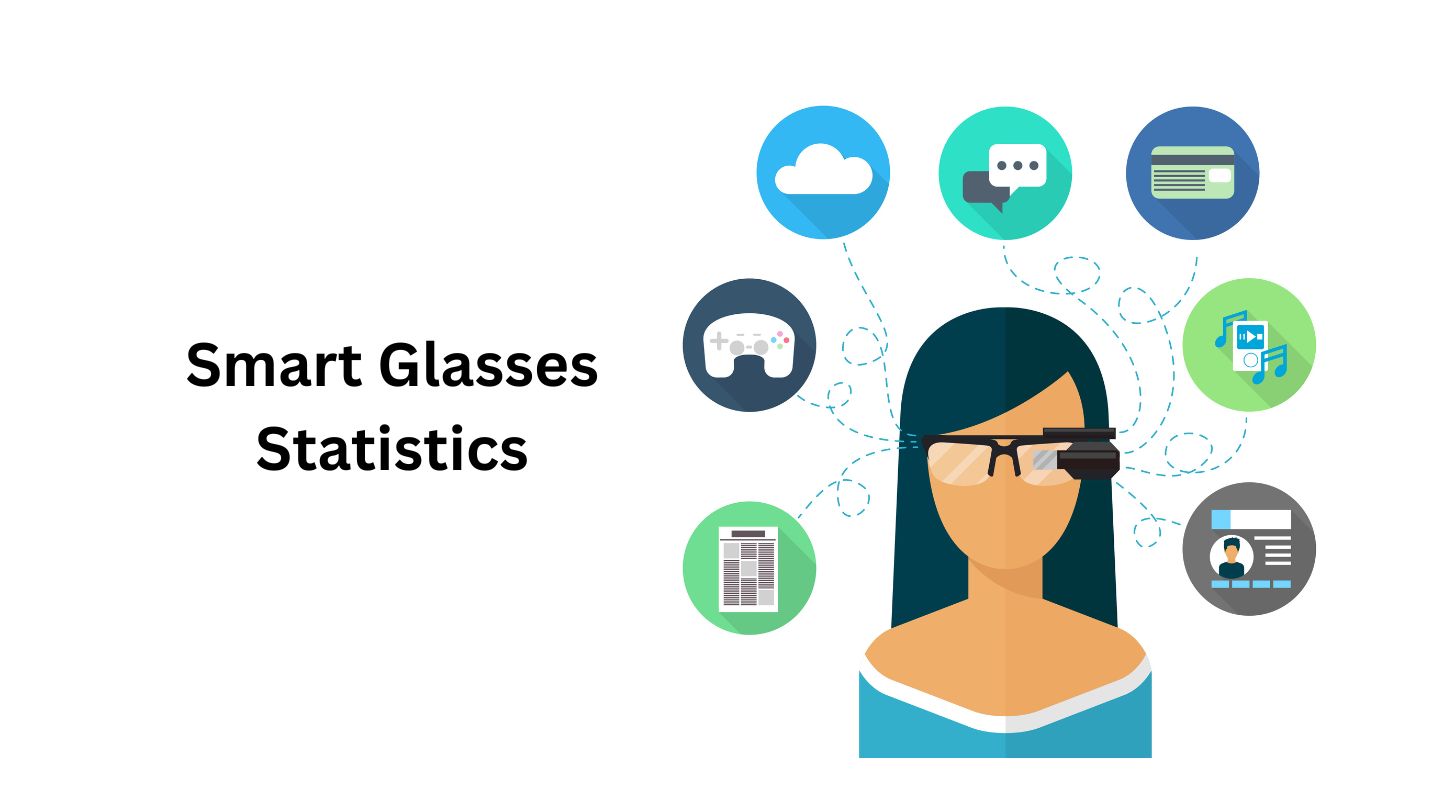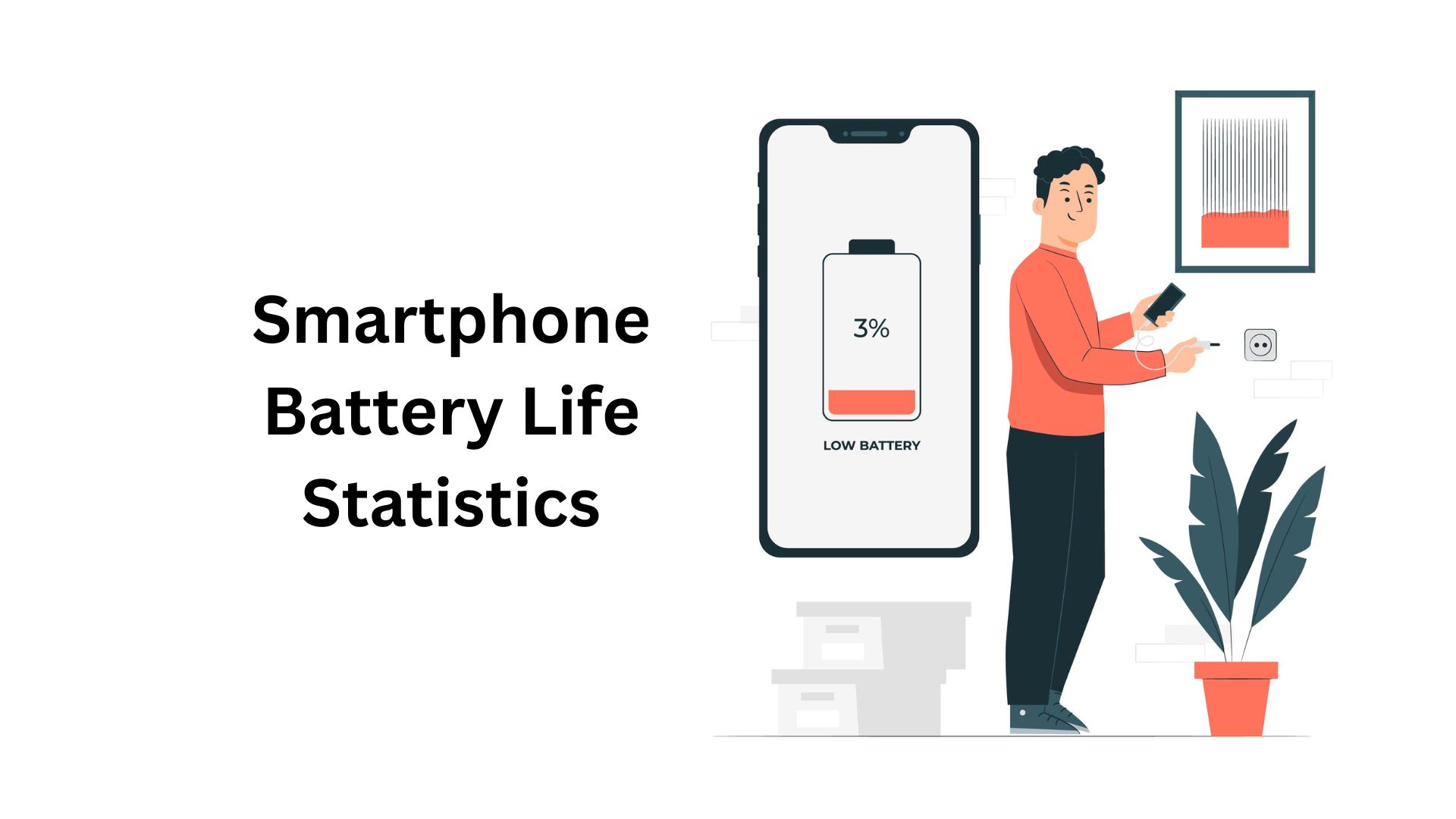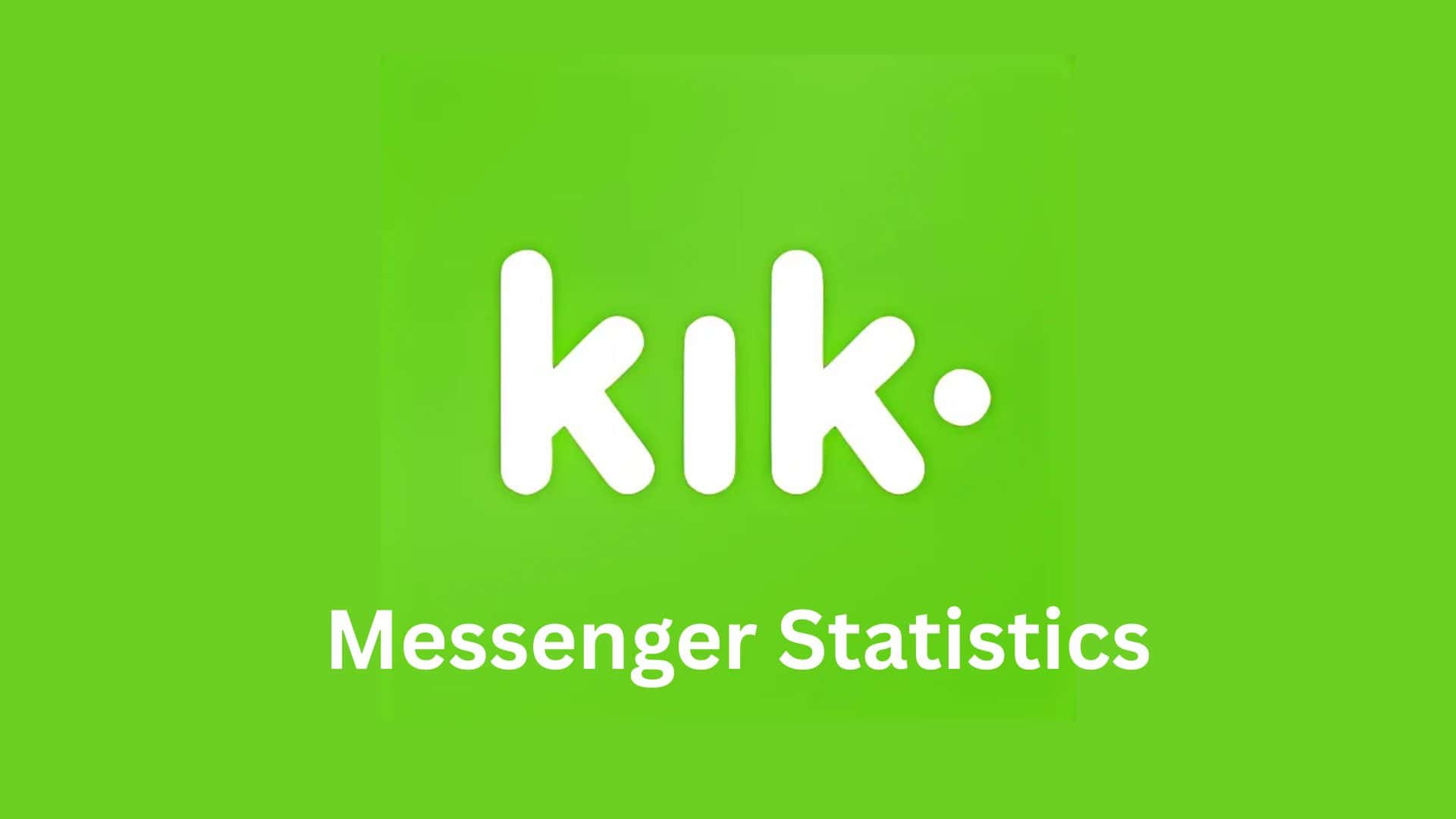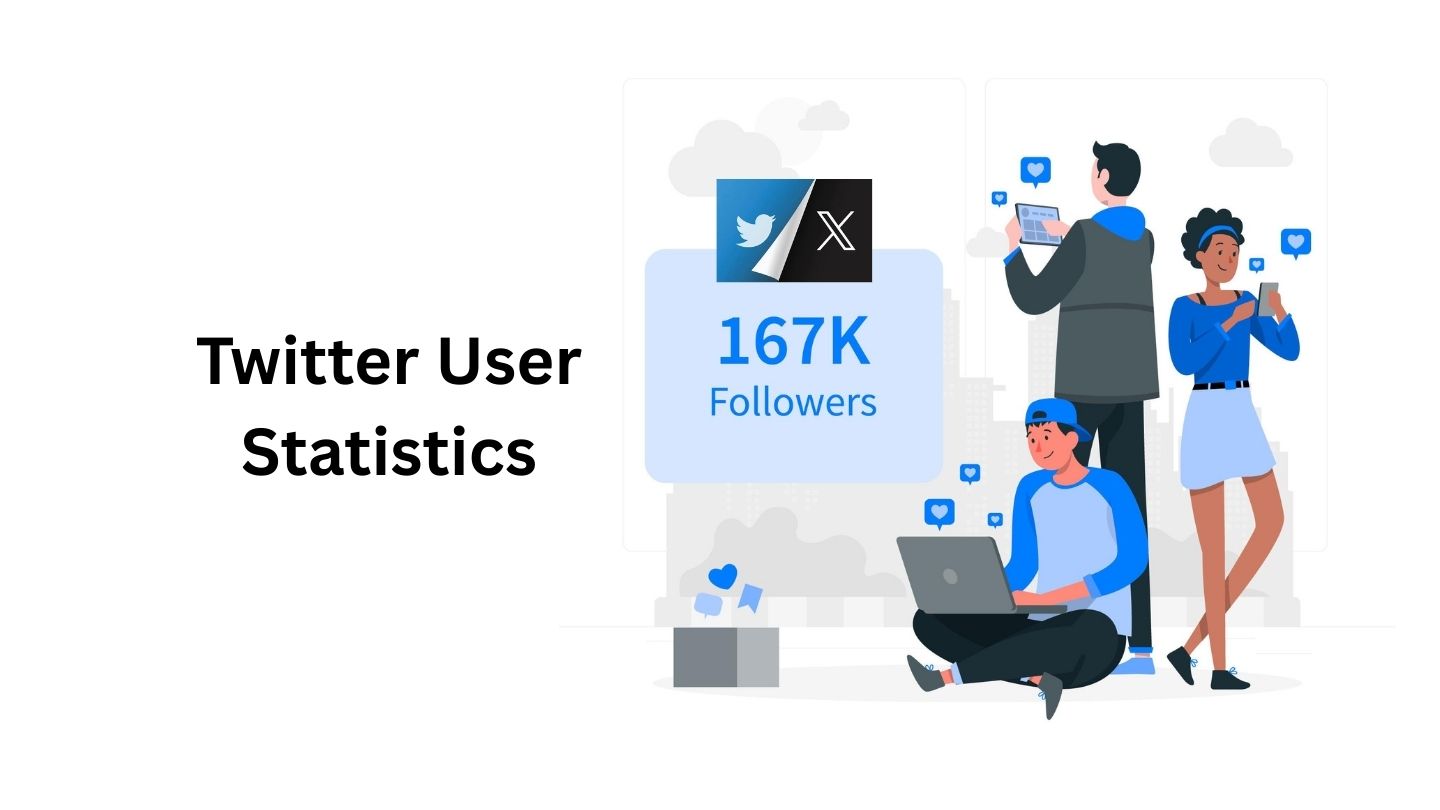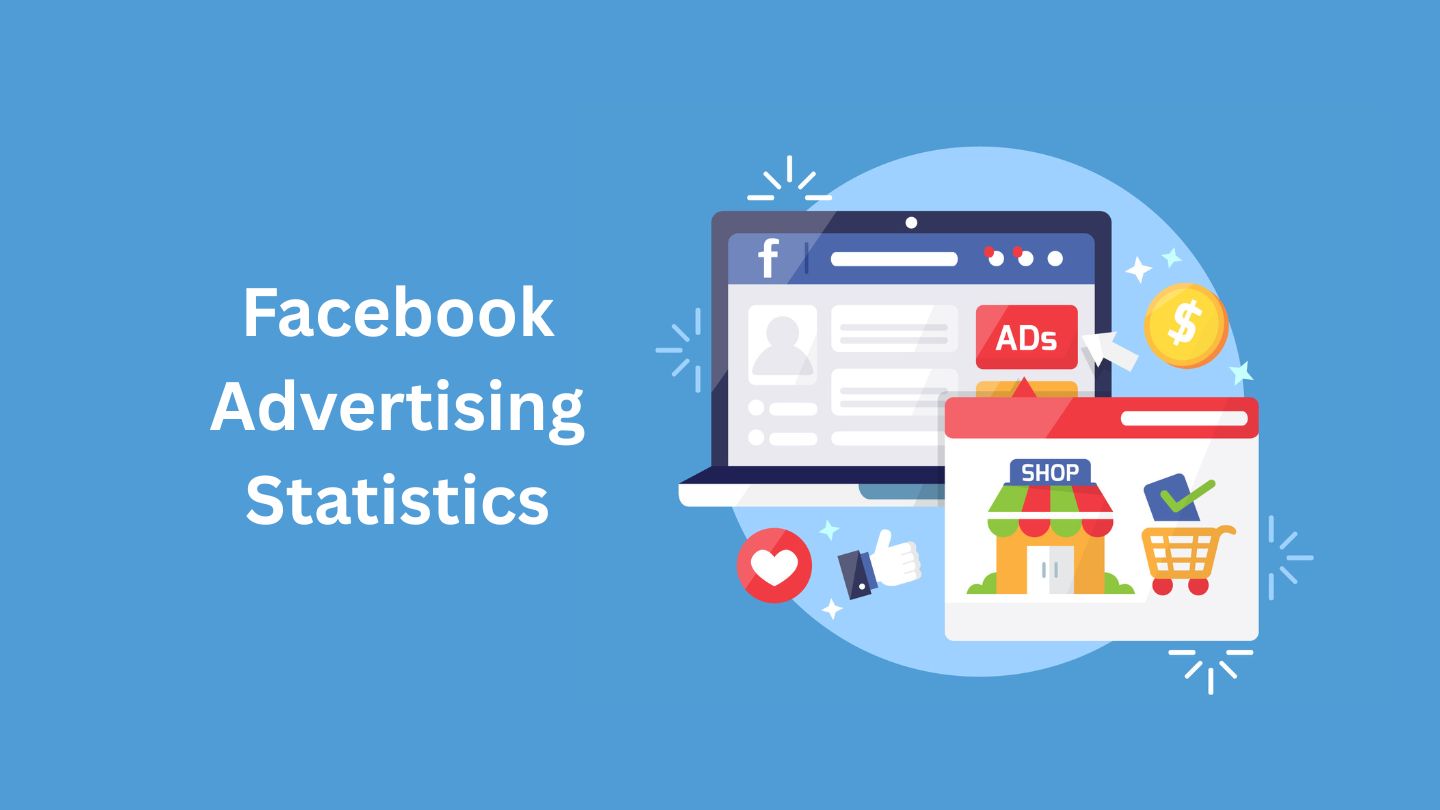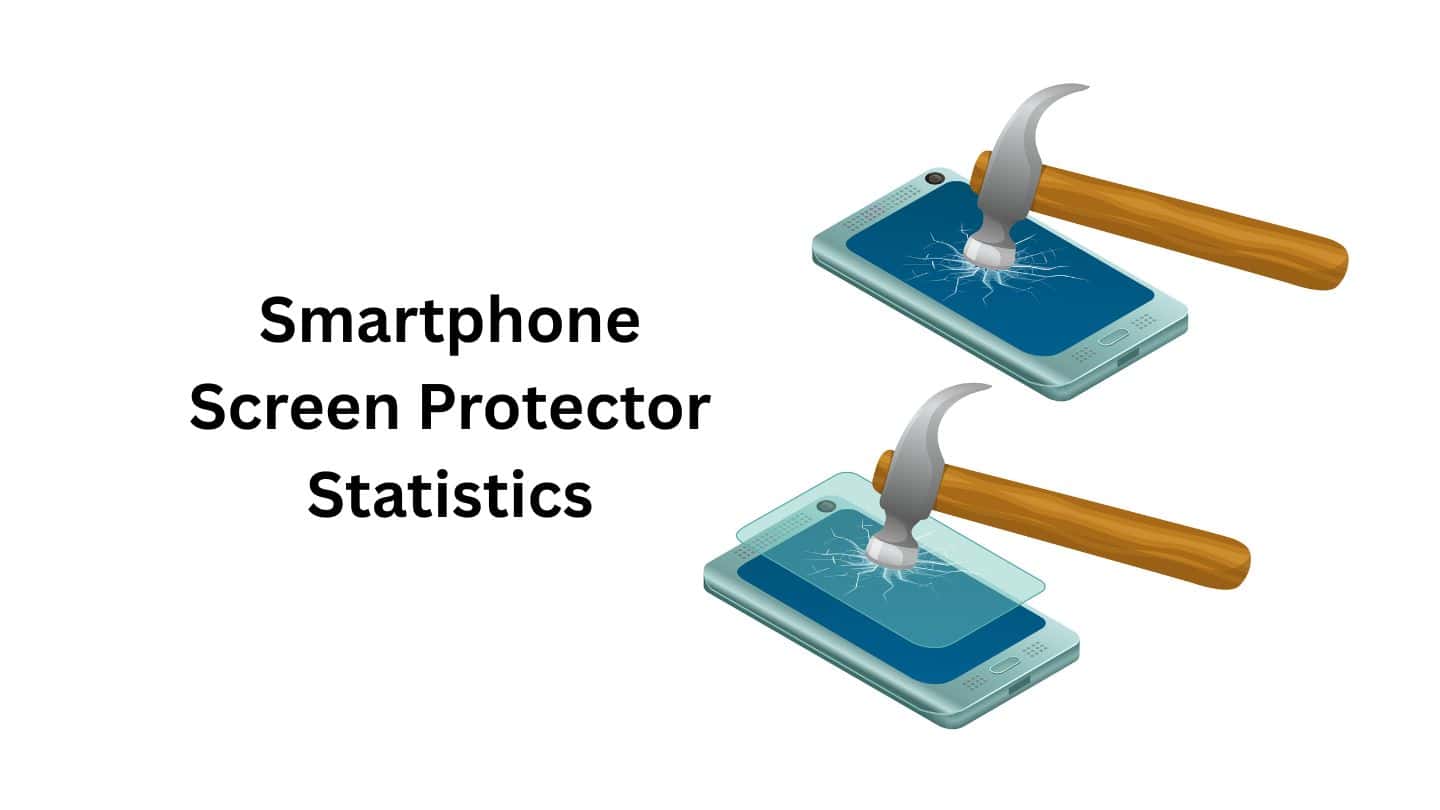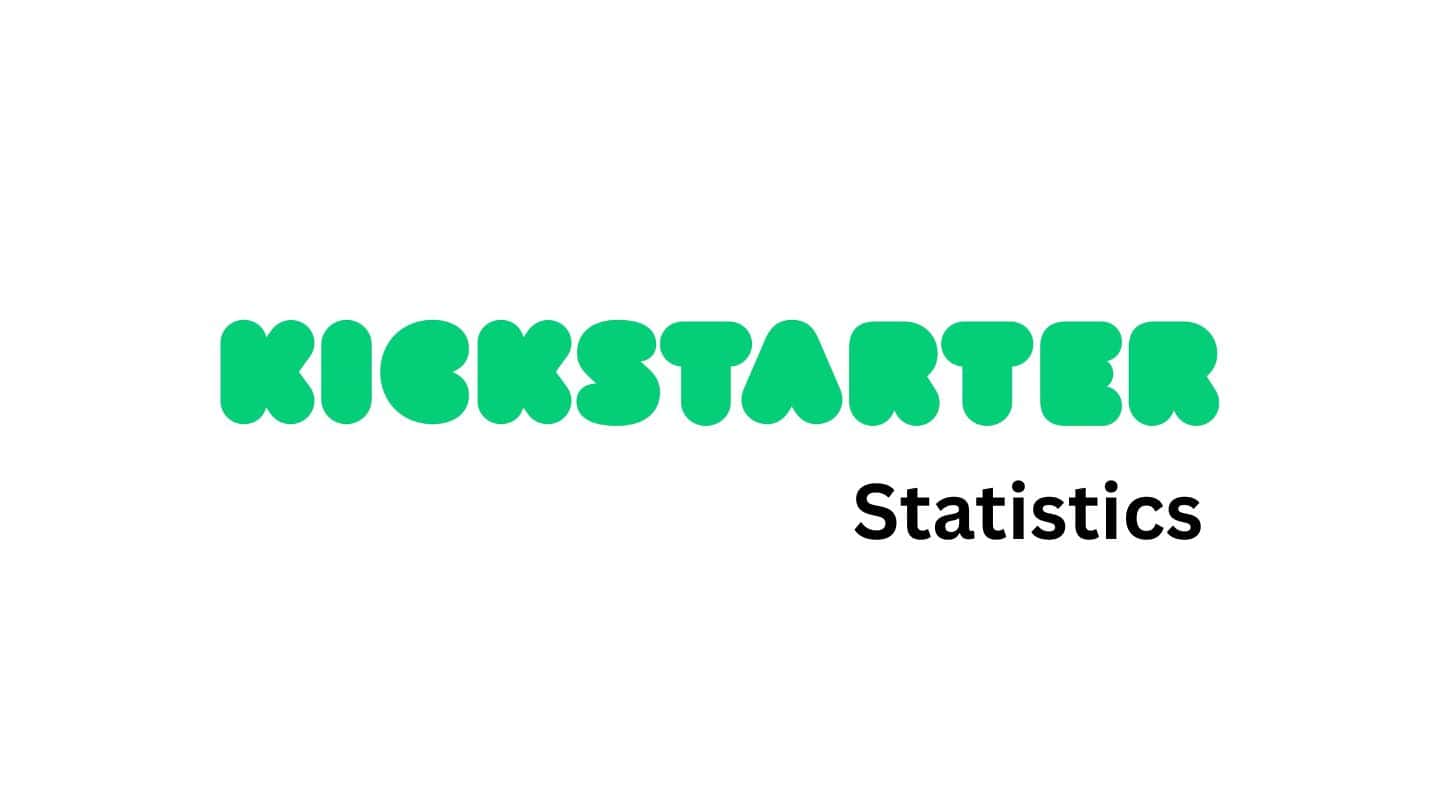Smart Glasses Statistics By Region, Technology, Users and Facts

Updated · Apr 17, 2025


TABLE OF CONTENTS
- Introduction
- Editor’s Choice
- Smart Glass Market Size
- Smart Glass Statistics By Region
- Common Uses of Smart Glass
- Smart Glass Statistics By Technology
- Types of Smart Glasses
- Smart Glass Statistics By Users
- Global Market of Smart Glass Statistics
- By Automotive Smart Glass
- Recent Developments
- Smart Glass Statistics of Website Traffic
- Top Brands of Smart Glasses
- Conclusion
Introduction
Smart Glasses Statistics: The Global Smart Glass Market size is expected to be worth around USD 13.2 billion by 2032, from USD 5.5 billion in 2023, growing at a CAGR of 10.5% during the forecast period from 2023 to 2033. In recent years, the demand for smart glasses has increased enormously around the world as these glasses can perform many complex computer-powered tasks. On the other side, because of advancements in technology, the demand for smart glasses has increased, and thus, the demand for wearable technology has increased accordingly. After the implementation of 5G technology, the market has started experiencing more benefits, and hopefully, the market share will grow more rapidly in the coming years.
These Smart Glasses Statistics include many insights from various sources or aspects that will shed light on the importance of Smart Glasses in the current situation worldwide.
Editor’s Choice
- The global smart glasses market is projected to grow from USD 878.8 million in 2024 to USD 4,129.3 million by 2030, holding a growth rate (CAGR) of 29.4%.
- The wearable technology sector, encompassing devices like smart glasses, is expected to reach USD 79 billion in 2024 and USD 94 billion in 2025.
- Global smart glasses shipments surged by 210% year-over-year (YoY) in 2024, driven by strong demand for products like the Ray-Ban Meta smart glasses.
- The number of smart glasses users in the United States is projected to increase from 12.61 million in 2023 to 13.72 million in 2024 and 14.39 million in 2025.
- Sales of augmented reality (AR) headworn devices are expected to reach 1.49 million units in 2024 and 1.63 million units in 2025.
- Since their launch in October 2023, over 2 million pairs of Ray-Ban Meta smart glasses have been sold. By the end of 2026, the company plans to produce 10 million units annually.
- The market value of micro LED AR glasses starts at USD 0.1 million in 2023 and is predicted to grow to USD 41 million by 2026.
- Apple announced the development of Vision Pro developer kits in September 2023.
- The worldwide market for smart glasses is predicted to grow at a rate of 13.2% from 2023 to 2029.
- Qualcomm has announced the development of new chips for VR and AR, named Snapdragon XR2 Gen 2 and ARI Gen 1.
- Major companies in the smart glass market include Polytronix Inc., Saint-Gobain, PPG Industries, Raven Brick LLC, and Pulp Studio.
- Smart glasses are divided into two types: active (using suspended particle devices, electrochromic, and liquid crystals) and passive (using photochromic and thermochromic technologies).
You May Also Like To Read
- Smart City Statistics
- Smart Home Statistics
- Smart Rings Statistics
- Smart TV Statistics
- Smart Clothing Statistics
- Smart Door Lock Statistics
- Smart Door Statistics
- Smart Fans Statistics
- Smart Bed Statistics
Smart Glass Market Size
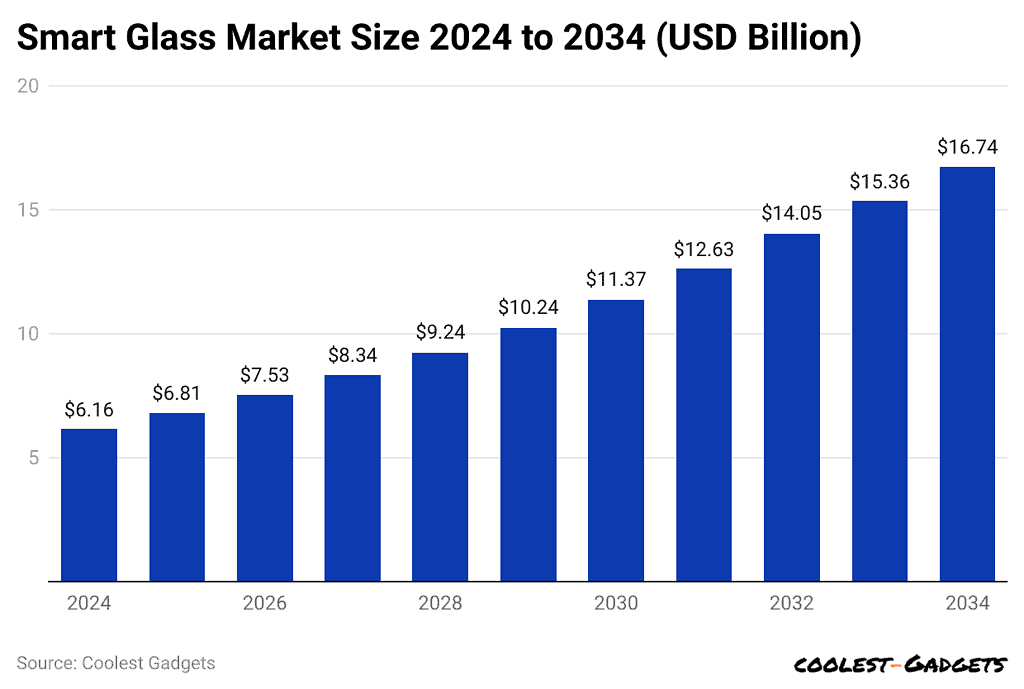
(Reference: precedenceresearch.com)
- The Global Smart Glass Market was valued at USD 6.16 billion in 2024.
- Experts predict it will grow to about USD 16.74 billion by 2034.
- This means the market is expected to expand at an average annual growth rate of 10.51% from 2025 to 2034.
- The smart glass industry is anticipated to grow from USD 6.2 billion in 2024 to USD 10.8 billion by 2029, at a CAGR of 11.70%.
- The market is projected to reach an estimated value of USD 5.65 billion by 2032.
- The Asia-Pacific transportation sector is expected to experience the highest CAGR, exceeding 12% through 2032, supported by increasing disposable incomes and a growing demand for high-end automobiles.
- In 2024, North America made up 33.13% of the total revenue in the smart glass market.
- The European market is expanding steadily, with an annual growth rate of 12.8%.
- From 2025 to 2034, the SPD technology sector is set to grow at a yearly rate of 12.6%.
- The transportation industry is predicted to see a 13.2% rise each year between 2025 and 2034.
- The construction field is projected to increase at a yearly rate of 12.3% during the same period.
- Leading companies in the smart glass market include Saint-Gobain S.A., Corning Incorporated, Guardian Industries, Nippon Sheet Glass Co., Ltd., and Kinestral Technologies, Inc.
- Smart glass can reduce energy consumption by up to 40% in buildings.
Smart Glass Statistics By Region
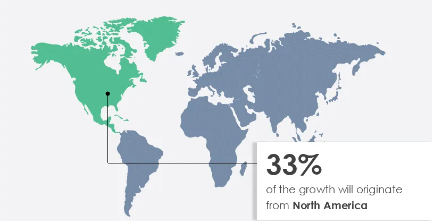
(Source: technavio.com)
- Furthermore, the North American region is termed the hub of Original Equipment Manufacturers of Smart Glasses such as Microsoft, Alphabet, Optinvent, Atheer Inc., and Vuzix.
- According to the research of Mordor Intelligence, in North America starting from the year 2023 to 2028, the smart glass market share is expected to grow at a CAGR of 14.3%.
- Smart glasses are mostly used in the sectors of U.S. construction as this sector includes the use of electricity (76%) and greenhouse gas emissions (40%).
- In the European nation, the market growth of the smart glass market is estimated to have a CAGR of 13.9% from 202 to 2028.
- In this nation, smart glasses are mostly used in transportation and aerospace industries as these glasses provide UV protection and solar reduction by 98% and 40% respectively.
- In China, the smart glass market growth is expected to enhance at a CAGR of 14% from 2023 to 2028.
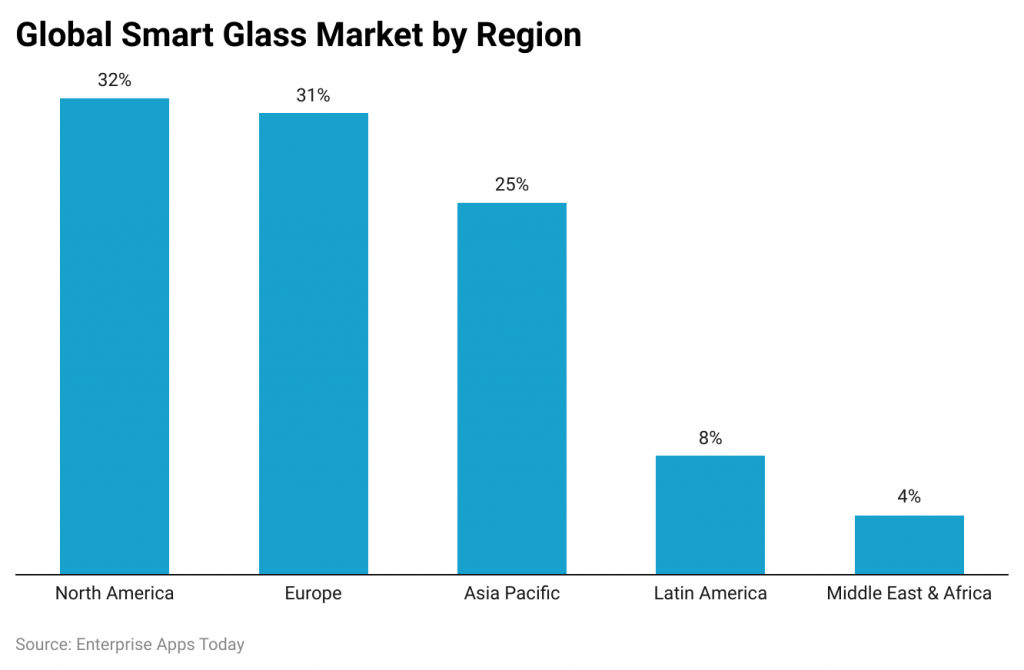
(Reference: coherentmarketinsights.com)
- The above graph describes the usage of smart glass across different regions in 2023 followed by North America (32%), Europe (31%), Asia Pacific (25%), Latin America (8%), and Middle East and Africa (4%).
- According to the reports of Coherent Market Insights, by 2030, the smart glass market in North America is expected to reach around USD 1,412.4 million.
Common Uses of Smart Glass
- A variety of things is now possible for smart glasses. Firstly, they are now designed and developed in such a way that smart glasses can send and reply to messages, along with calling and receiving phone calls.
- Other features are the ability to take photos and capture videos, enable GPS navigation, allow managing calendars’ appointments, and pop-up reminders.
- These smart glasses also commonly interact with other applications within the Smartphone such as audio books, podcasts, music, Uber, etc.
- Other commercial and enterprise uses of smart glass are warehousing, navigation, entertainment, manufacturing, gaming, remote support, and learning.
Smart Glass Statistics By Technology
- The market share of the suspended particle segment of smart glass is expected to grow at a CAGR of 12.6% from 2023 to 2032. This technology is most used in the transportation sector, with a CAGR of 13.2% from 2023 to 2032.
- The expected global electrochromic glass market is going to reach a CAGR of 9.37% from 2023 to 2028.
- In 2023, the largest revenue share is accounted for by the Polymer-dispersed Liquid Crystals (PDLC) segment with a share of over 28%. By the end of 2030, the Architectural and Transportation smart glass market is expected to account for a revenue share of USD 5,438.3 million with a CAGR of 10.1% and USD 4,839.7 million with a 10.2% share from 2023 to 2030, respectively.
- The global smart glass market shares by technology in 2023 are as follows: electrochromic (83.82%), Liquid Crystal (9.01%), SPD (0.43%), Thermochromic (2.27%), and Photochromic (4.47%).
Types of Smart Glasses
- Monocular Smart Glasses: Common examples are Lumus Sleek, Google Glass, Optivent’s Ora-2, and Vuzix M300. These glasses have head-mounted displays which include an optical engine on 1 lens.
- Binocular Smart Glasses: Examples are Epson, SONY SED-E1, Moverio, and ODG R-9. These glasses consist of two different transparent displays with an optical engine that provides stereoscopic vision to users.
- Audio Augmented Reality Smart Glasses: The best example is Bose Frames, these glasses mainly utilize sound-based AR and are associated with visuals. They are mostly attached through phone GPS and motion sensors that allow for generating sound directly to the ears.
- Immersive or Mixed-Reality Smart Glasses: The best examples are ODG-9 smart glasses and Microsoft HoloLens. These glasses are made up of stand-alone systems that mostly allow the viewing of 3D images or objects.
- Mixed Reality Photo Projection Action: A common example is Magic Leap; the main aim of the smart glass is to project photons directly into the user’s eyes and allow them to fix common drawbacks effectively.
Smart Glass Statistics By Users
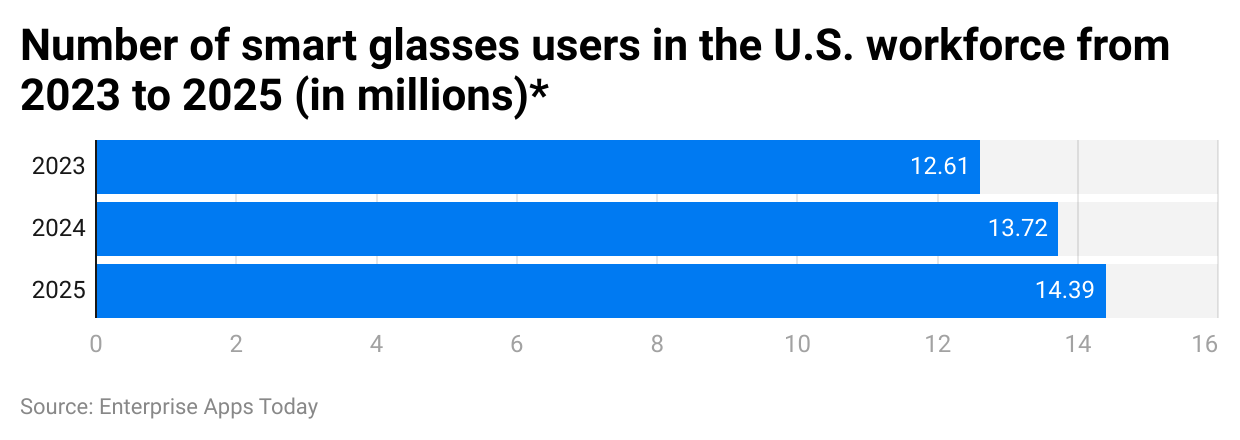
(Source: statista.com)
- According to the reports of Statista, in the United States, the total number of users of smart glasses in 2023 is expected to be 12.61 million.
- Furthermore, smart glasses are supposed to be adopted by the American people are 13.72 million and 14.39 million by the end of 2024 and 2025 respectively.
Global Market of Smart Glass Statistics
By AR Glasses
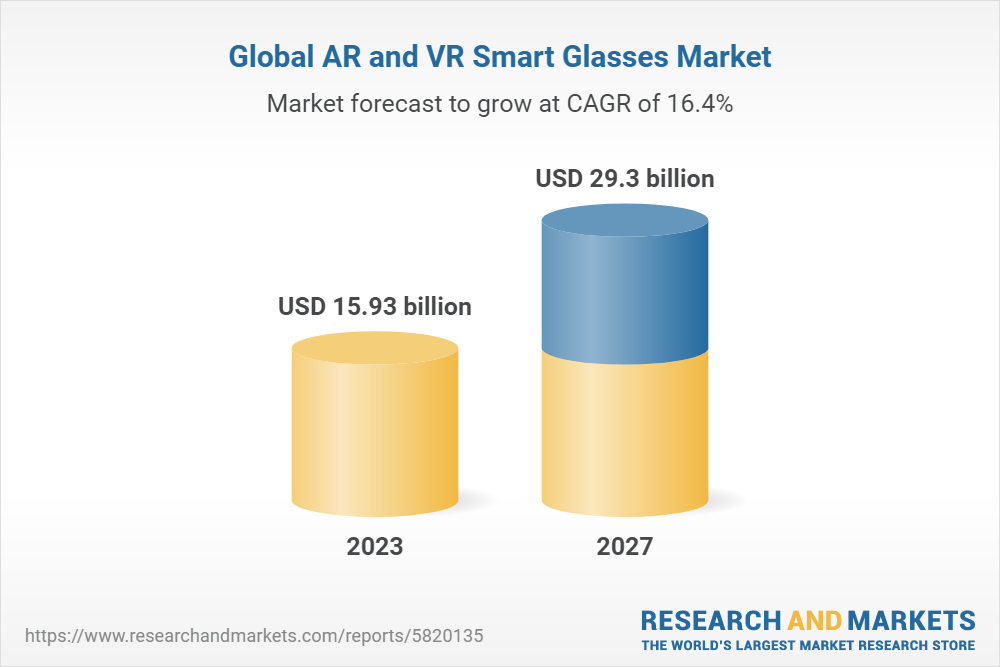
(Reference: researchandmarkets.com)
- According to the reports of Research and Markets, the market share of Augmented Reality and Virtual Reality Smart glasses by 2023 is going to be USD 15.93 billion.
- On the other side, by the end of 2027, the market share is going to grow around USD 29.3 billion with a CAGR of 16.4%.
- According to Statista, around the world total AR glasses unit sales in 2023 is around 2.11 million and by the end of 2024, it is going to be 3.9 million.
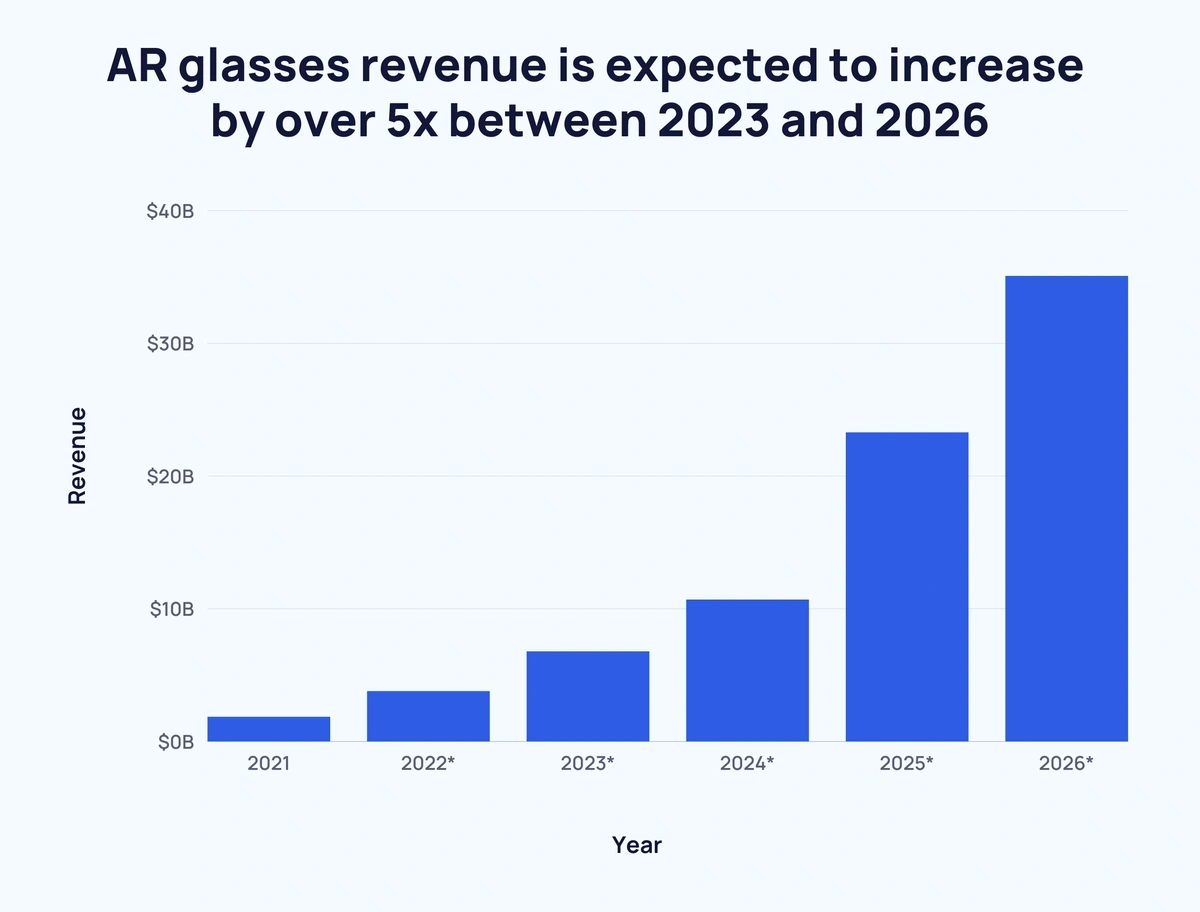
(Source: buttercms.com)
- As of reports of ARtillery Intelligence, the market value of both software and hardware AR glasses has increased by USD 6.77 billion in 2023, which has increased by 104.3% from 2022.
- The revenue share of AR glasses is predicted to increase 5 times by the end of 2026 to around USD 35 billion.
By Automotive Smart Glass
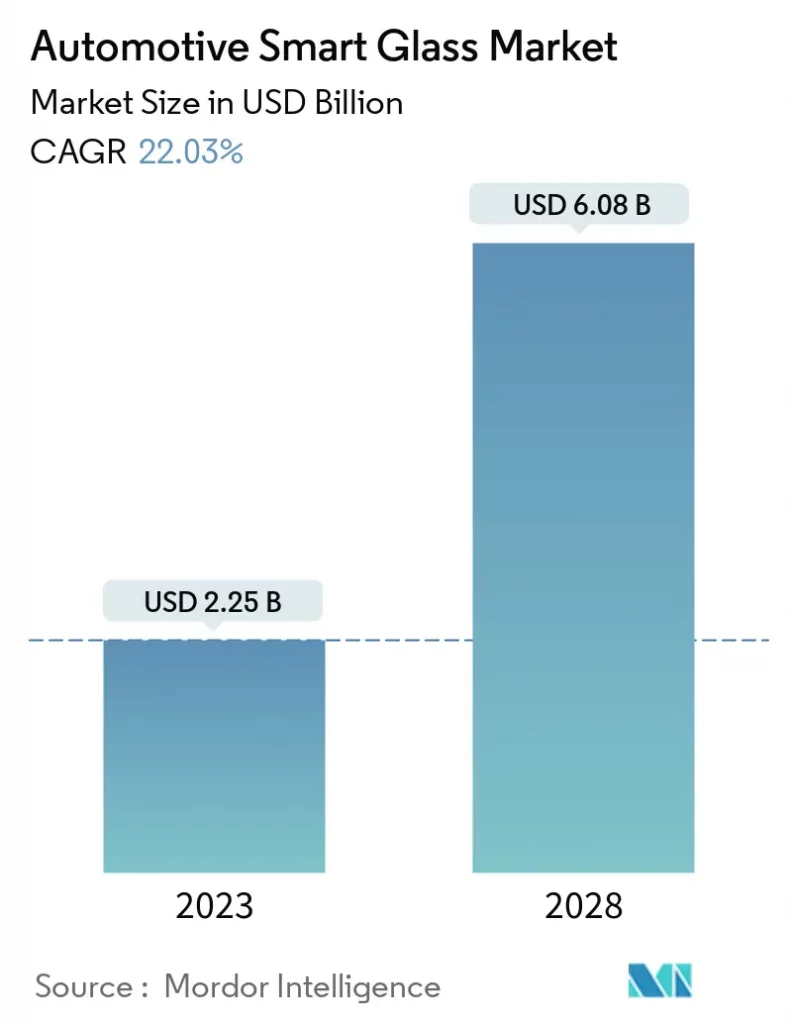
(Source: mordorintelligence.com)
- The market size of the automotive smart glass market in 2023 is expected to be USD 2.25 billion, and by 2028 the market is going to expand more to around USD 6.08 billion with a CAGR of 22.03% from 2023 to 2028.
- At the current time, the largest market share in the automotive smart glass market remains highest in the North American region, and the fastest growing regions are Asia-Pacific and Europe.
Recent Developments
Acquisitions and Mergers:
- Meta (formerly Facebook) acquired Luxexcel for USD 400 million in early 2024. Luxexcel specializes in 3D-printed prescription lenses, aiming to enhance Meta’s augmented reality (AR) capabilities (Market.us Scoop).
- Google completed its acquisition of North for USD 180 million in late 2023. North is known for its pioneering smart glasses technology, which will now be integrated into Google’s AR hardware development efforts (Market.us Scoop).
New Product Launches:
- Apple launched its AR glasses, Apple Vision, in mid-2023. These glasses feature advanced AR capabilities, high-resolution displays, and integration with the Apple ecosystem, targeting both consumer and enterprise markets (Market.us Scoop).
- Ray-Ban Stories, a collaboration between Meta and Ray-Ban, was introduced in late 2023. These glasses incorporate features like hands-free calling, photo and video capture, and integration with social media platforms, blending style with functionality (Market.us Scoop).
Funding:
- Magic Leap raised USD 500 million in early 2024 to support the development of its next-generation AR smart glasses, which aim to enhance AR capabilities and expand market presence (Market.us Scoop).
- Vuzix secured USD 200 million in mid-2023 to scale production and invest in new technologies for their enterprise-focused smart glasses (Market.us Scoop).
You May Also Like To Read
- Smart Video Doorbell Statistics
- Google Home Smart Device Statistics
- Smart Alarm Systems Statistics
- Smart Refrigerators Statistics
- Smart Bulb Statistics
- Smart Home Cameras Statistics
- Smart Kitchen Appliances Statistics
- Smart Switches Statistics
- Smart Robot Vacuum Cleaners Statistics
- Smart AC’s Statistics
- Smart Home Devices Statistics
- Smart Washing Machine Statistics
- Smart Dishwasher Statistics
Smart Glass Statistics of Website Traffic
By Country
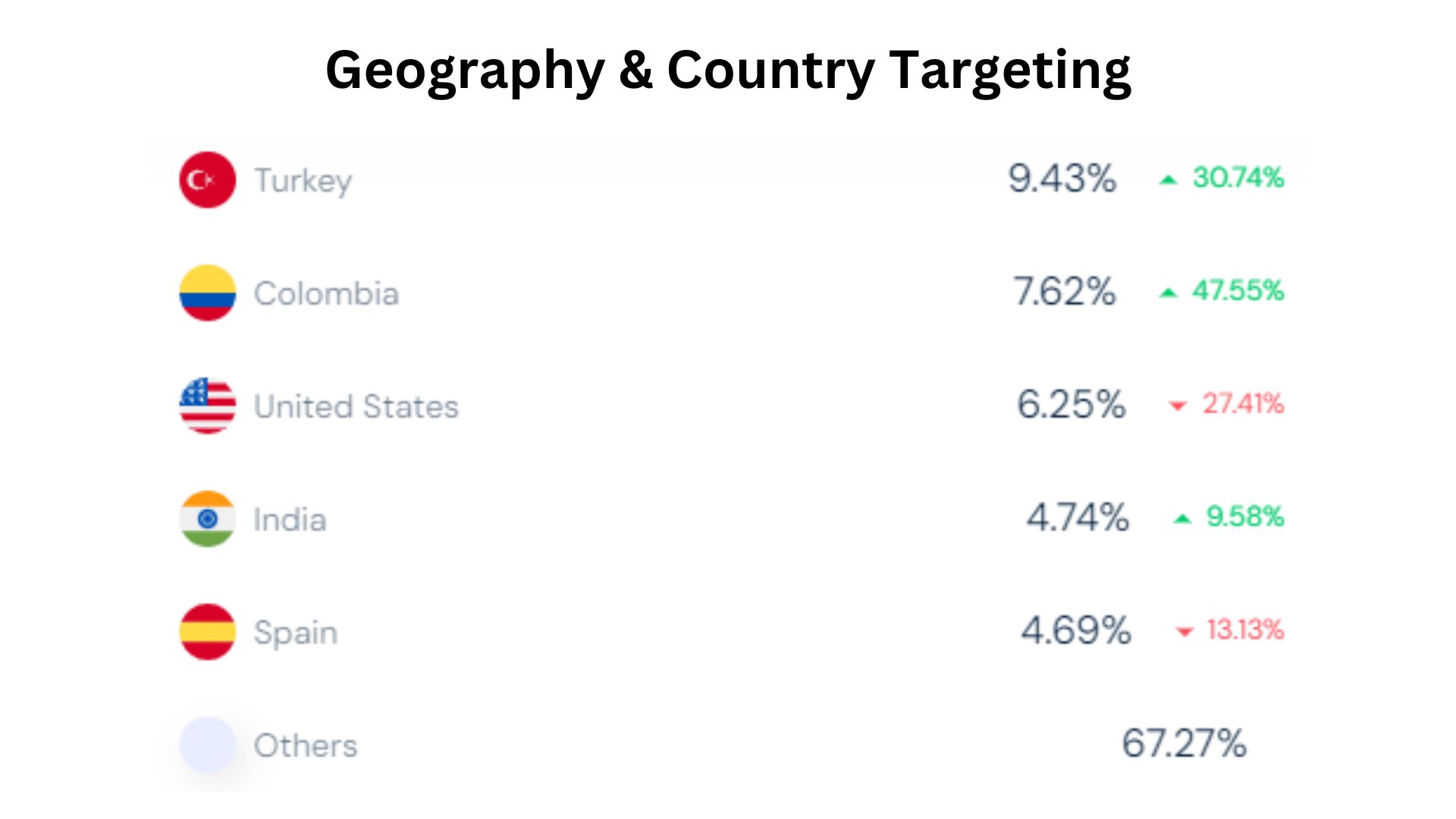
(Source: similarweb.com)
- As of 2023, Turkey is having the total website traffic on smartglass.com with 9.43% visitors, but the site has experienced an increment in the total website visitors by 30.74%.
- The website visitor’s shares are followed by Colombia with 7.62%, which increased by 47.55%.
- Furthermore, other countries’ website traffic shares are followed by the United States (-27.41%), India with 4.74% (+9.58%), Spain with 4.69% (-13.13%), and the rest of the countries collectively made a total visitor share of 67.27%.
- As of September 2023 global rank of the website smartglass.com resulted from 13,991 and the total visits turned out to 14.3K increased by 10.34% from last year.
Top Brands of Smart Glasses
- As of 2023, the overall best smart glass is Xreal Air AR Glasses, which is developed in a stylish pattern with a modern frame and stylish design. Some advantages are that it is capable of lots of multitasking features and includes immersive virtual workspaces. This smart glass is available at Amazon for USD 380.

- The next best smart glass is Lenovo ThinkReality A3, which is a premium AR glass mostly used by Windows users. This offers a Bluetooth audio connection and an advanced control system, which also enables stable and reliable virtual workspaces. This smart glass is available on Amazon at USD 1499.

- OhO Bluetooth Sunglasses system is based on Bluetooth 5.0 and offers a light smart glasses option. This includes multiple color options, open-ear speaker technology that allows you to talk on the phone, and listen to music, and a waterproof design that is available at Amazon for USD 32.
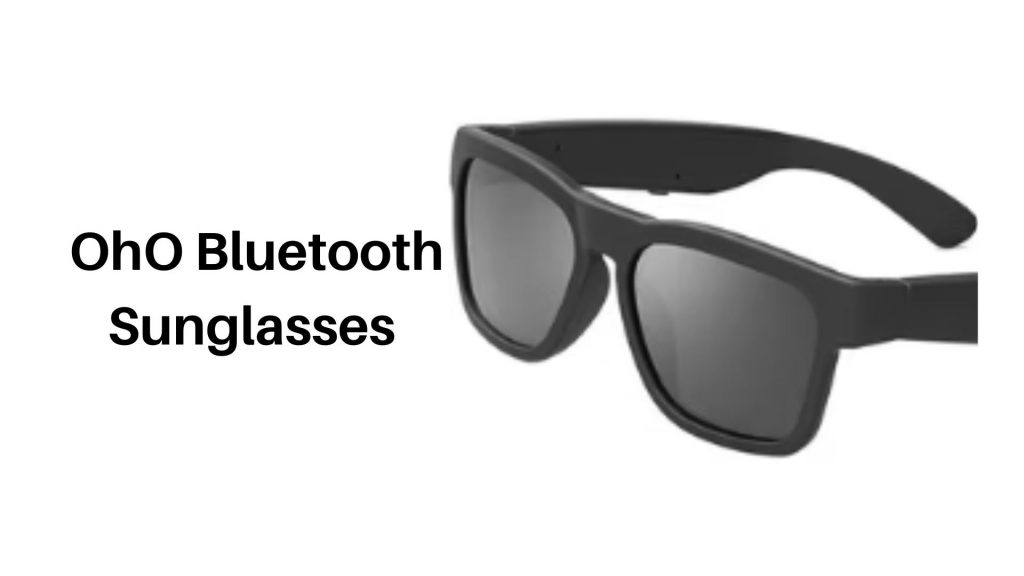
- Ray-Ban Stories is another best-looking smart glasses that is available at Amazon for USD 329. This smart glass comes with rechargeable cases with effective battery life, an excellent speaker system, and great style and design.
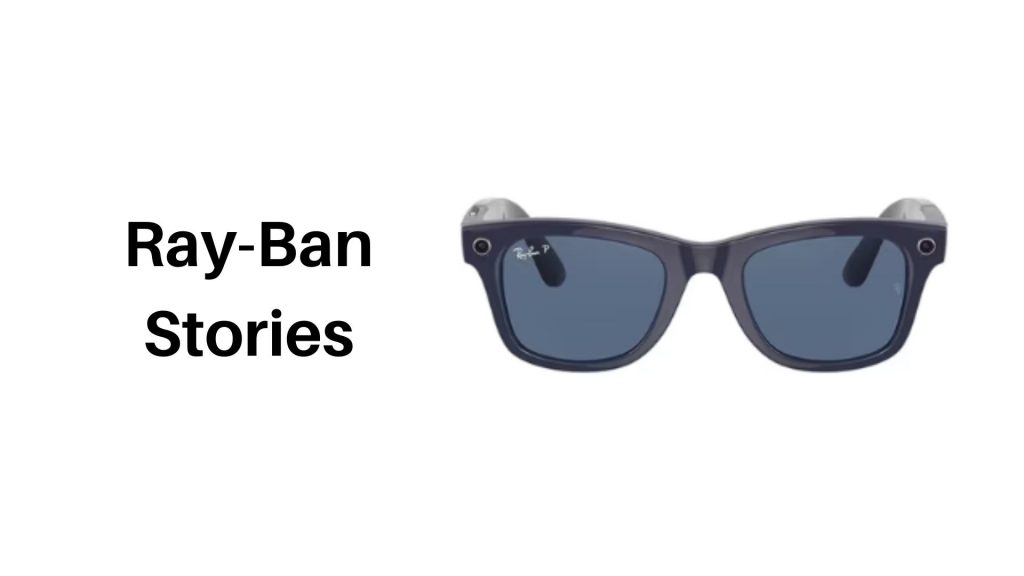
- Snap Spectacles 3 is best used for Snapchat users and is better for content creators for capturing footage and creating videos on Snapchat with a storage of 1,000 photos and 100 videos. This smart glass has a stylish look and involves high-definition cameras with 4GB of flash storage.
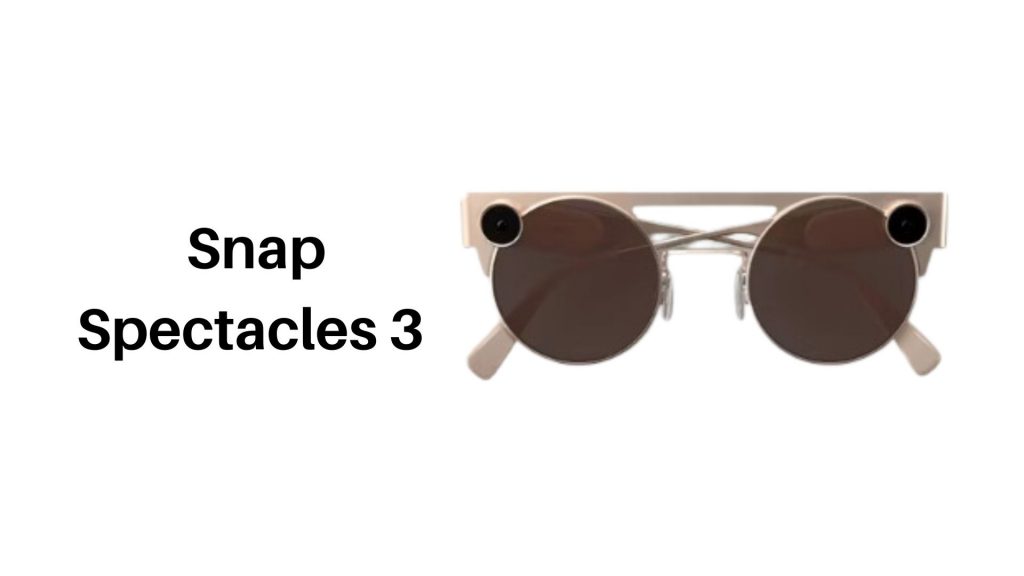
- TCL NXTWears RayNeo XR Glasses include physical buttons on the side of glasses that make interaction easier and are easily available at Amazon for a range of USD 400. The positive sides of this smart glass are extremely comfortable to wear and low blue light protection is better for the eyes.
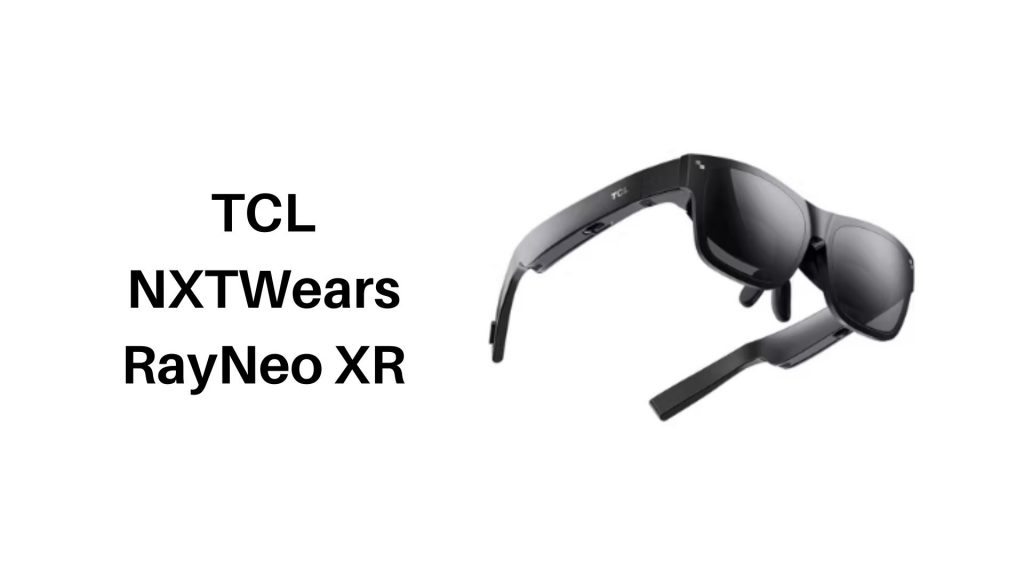
Conclusion
Smart glasses are a big step in technology, making life easier in many ways. They help people see information quickly, stay connected, and even improve work and learning. Features like voice control, navigation, and health tracking bring new possibilities. However, privacy and cost are still concerns. As technology improves, smart glasses will become more useful and affordable.
In the future, they might replace smartphones or become even smarter with AI. While challenges remain, smart glasses are shaping the way we interact with the world, making daily tasks simpler and more convenient for everyone.
Sources

Barry Elad is a tech enthusiast passionate about exploring various technology topics. He collects key statistics and facts to make tech easier to understand. Barry focuses on software and its benefits for everyday life. In his free time, he enjoys creating healthy recipes, practicing yoga, meditating, and walking in nature with his child. Barry's mission is to simplify complex tech information for everyone.



